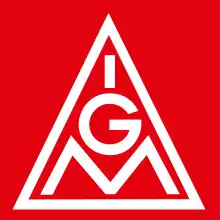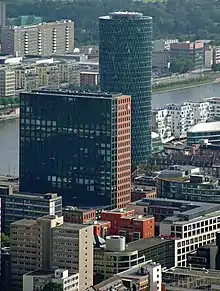German Metalworkers' Union | |
Industriegewerkschaft Metall | |
 | |
| Founded | September 1, 1949, West Germany |
|---|---|
| Headquarters | Frankfurt, Germany |
| Location | |
Members | 2.27 million[1] |
Key people |
|
| Affiliations | DGB |
| Website | www |

IG Metall (German: [iːɡeː meˈtal] ⓘ; IGM; German: Industriegewerkschaft Metall, "Industrial Union of Metalworkers'") is the dominant metalworkers' union in Germany, making it the country's largest union[1] as well as Europe's largest industrial union.[2] Analysts of German labor relations consider it a major trend-setter in national bargaining.
IG Metall and ver.di together account for around 15 percent of the German workforce, and other sectors tend to broadly follow their agreements.[3]
History
The name IG Metall refers to the union's metalworkers roots dating back to the start of unions in imperial Germany in the 1890s, though this formal organization was founded post-war in 1949.[4] Over the years the union has taken on representation in industries beyond mining of minerals to include manufacturing and industrial production, machinists, printing industry, which includes modern automobile manufacturing and steel production as part of its blue-collar root, but also includes more white-collar sectors such as electrical and other forms of engineering, information systems, and with the combining of formerly separate unions for workers in wood, plastics, textiles and clothing, includes non-metal blue-collar workers. On April 1, 1998, the Textile and Clothing Union (GTB) joined IG Metall. On January 1, 2000, the Wood and Plastic Union (GHK), also joined.[4]
Deals agreed by IG Metall in the pilot region of Baden-Württemberg, an industrial and car-making hub and home to Daimler and Bosch, have traditionally been serving as a template for agreements across the country.[5]
Major accomplishments of IG Metall in the German labor market include, applied to the regions/covered employees:[4]
- Five-day work week (1959)
- Paid vacation time concessions (1962)
- 40 hr work week (1965–1967)
- Paid sick leave (1956)
- 35-hour work week (attempts not yet successful 1984)
- 35-hour work week in metal industry (1995)
Most recently, IG Metall agreed to a landmark deal with employers in 2016, giving 3.8 million workers in the metalworking sector a two-stage pay rise of 4.8 percent over 21 months.[6] After a series of strikes, the union agreed a deal in 2018 to allow staff to cut their working week to 28 hours for up to two years to care for children or other relatives.[7] Amid the COVID-19 pandemic in Germany, IG Metall notably proposed negotiating for a move to a four-day week to help secure jobs against economic fallout from the coronavirus crisis and structural shifts in the automobile industry.[7]
Major strikes
Strikes are rare in Germany, where companies and unions strive for consensus whenever possible. One of the first strikes of IG Metall lasted seven weeks in 1984 in the states of Baden-Württemberg and Hesse, which led to a reduction in the workweek to 35 hours from 37. Another major strike was organized by IG Metall in 1995, when up to 11,000 workers in Bavaria remained off the job for two weeks.[8][9] In 2002, IG Metall called a wave of one-day strikes in a demand for a 6.5 percent increase in wages; German industry settled the dispute two weeks later by offering a raise of roughly 4 percent.[10][11] In 2003, the union was forced to drop its campaign for a shorter workweek in the factories of eastern Germany after its hard-nosed negotiating tactics were repudiated by Germans across the political spectrum.[12] In early 2018, more than 900,000 workers took part in industrial action in support of IG Metall's demands for higher pay and the right to shortened working hours.[13]
In 2022, German union IG Metall has demanded an 8.2% rise for workers and was rejected by employers for a 4.7% increase for 21 months. After third round of talks with the employers the rejection led them to call for steel workers to hold further warning strikes.[14]
Membership
Today IG Metall mainly represents employees at major car makers, such as Daimler, BMW, Porsche, Volkswagen, Audi and industrial giants such as Siemens, ThyssenKrupp, Airbus, Salzgitter AG, ArcelorMittal, Bosch, ZF and smaller mechanic construction companies and car-mechanics. Its membership had been dropping in recent decades — it lost 250,000 members in 1993 alone —,[15] yet the union managed to somewhat reverse that trend recently by gaining 30,000 members between 2010 and 2015.[1] A record in wage deals, along with a push to recruit more women, young people (e.g. students) and white-collar workers, helped it boost 2015 membership by 121,000 to 2.3 million and income by 3.4 percent to 533 million euros ($582 million); this rise came against a backdrop of generally declining union in Germany.[16]
Notable members
- Norbert Blüm — former Federal Minister of Labour and Social Affairs
- Sigmar Gabriel — former Vice Chancellor of Germany
- Hannelore Kraft — former Minister-President of North Rhine-Westphalia
- Heiko Maas — former Federal Minister for Foreign Affairs
- Hans Matthöfer — former Federal Minister of Finance
- Andrea Nahles — former Federal Minister of Labour and Social Affairs
- Svenja Schulze — former Federal Minister of the Environment, Nature Conservation and Nuclear Safety
- Carsten Sieling — former President of the Senate and Mayor of the Free Hanseatic City of Bremen
Organisation structure
Regional districts
IG Metall consists of 7 Bezirke (districts) which are subdivided in Verwaltungstellen (administrative areas):
- Bezirk Baden-Württemberg headquarters located in Stuttgart; 28 Verwaltungstellen
- Bezirk Bayern (Bavaria) headquarters located in Munich; 21 Verwaltungstellen
- Bezirk Berlin-Brandenburg-Sachsen (Berlin + Brandenburg + Saxony) headquarters located in Berlin; 12 Verwaltungstellen
- Bezirk Frankfurt (Saarland + Rhineland-Palatinate + Hesse + Thuringia) headquarters located in Frankfurt/Main; 27 Verwaltungstellen
- Bezirk Küste ("Küste"= "Sea Coast") (Bremen + Hamburg + Schleswig-Holstein + Mecklenburg-Western Pomerania + North Lower Saxony) headquarters located in Hamburg; 19 Verwaltungstellen
- Bezirk Niedersachsen und Sachsen-Anhalt (Middle/South Lower Saxony + Saxony-Anhalt) headquarters located in Hanover; 20 Verwaltungstellen
- Bezirk Nordrhein-Westfalen (North Rhine-Westphalia) headquarters located in Düsseldorf; 47 Verwaltungstellen
Chairs
| Era | Chair(s) | 2nd Chair |
|---|---|---|
| 1949–1950* | Hans Brümmer Walter Freitag Wilhelm Petersen | |
| 1950–1952 | Hans Brümmer | Walter Freitag |
| 1952–1956 | Hans Brümmer | Otto Brenner |
| 1956–1968 | Otto Brenner | |
| 1968–1972 | Otto Brenner | Eugen Loderer |
| 1972–1983 | Eugen Loderer | Hans Mayr |
| 1983–1986 | Hans Mayr | Franz Steinkühler |
| 1986–1989 | Franz Steinkühler | Karl-Heinz Jansen |
| 1989–1993 | Franz Steinkühler | Klaus Zwickel |
| 1993–1998 | Klaus Zwickel | Walter Riester |
| 1998–2003 | Klaus Zwickel | Jürgen Peters |
| 2003–2007 | Jürgen Peters | Berthold Huber |
| 2007–2013 | Berthold Huber | Detlef Wetzel |
| 2013–2015 | Detlef Wetzel | Jörg Hofmann |
| Since 20 October 2015[17] | Jörg Hofmann | Christiane Benner |
*Until 1956, IGM had two co-equal chairpersons. Thereafter, the organization changed to a 1st Chair and 2nd Chair, with the 2nd Chair being traditionally promoted to 1st Chair upon the retirement of the 1st Chair. However, Alois Wöhrle (1969) and Karl-Heinz Janzen (1992) retired without advancing to 1st Chair, while Walter Riester (1998) became Federal Minister of Labour and therefore dropped out.
International relations
IG Metall is a member of the German Trade Union Confederation (Deutscher Gewerkschaftsbund, DGB). IGM is also a member of some international union umbrella organisations, including the European Metalworkers' Federation (EMF) and the IndustriALL Global Union.
In 2015, IG Metall and the U.S. United Automobile Workers (UAW) announced that they would deepen their partnership and set up an office in Tennessee to boost labor rights at German automakers and their suppliers based in the United States.[18]
metall magazine
The IGM magazine, metallzeitung, has existed since 1949. In 2005 it had a circulation of over 2 million. There are 12 issues per year.
References
- 1 2 3 Erik Kirschbaum (June 8, 2015), Moderate head of powerful German union steps down unexpectedly Reuters.
- ↑ Hendrik Sackmann (May 18, 2012), German IG Metall, employers confirm 4.3 percent wage deal Reuters.
- ↑ Edward Taylor and Ilona Wissenbach (January 26, 2018), German union agrees to last-ditch talks to try to avert strikes Reuters.
- 1 2 3 Wikipedia DE
- ↑ Ilona Wissenbach (July 30, 2015), Germany's IG Metall union agrees 3.4 pct wage rise Reuters.
- ↑ Klaus Lauer (May 18, 2016), German construction workers agree two-stage wage rise Reuters.
- 1 2 Emma Thomasson (August 15, 2020), German union IG Metall backs four-day week to save jobs Reuters.
- ↑ Nathaniel Cushing Nash (February 25, 1995), Biggest German Union Begins Strike The New York Times.
- ↑ Edmund L. Andrews (February 18, 1999), Strike by Biggest German Union Is Averted The New York Times.
- ↑ Edmund L. Andrews (May 16, 2002), German Metalworkers' Union Wins Higher Wages The New York Times.
- ↑ Mark Landler (July 9, 2003), A German Union Takes Stock The New York Times.
- ↑ Mark Landler (July 22, 2003), Union Leader Retires Early in Feud Fallout The New York Times.
- ↑ Ilona Wissenbach (January 27, 2018), Strikes loom as German industrial wage talks end without a deal Reuters.
- ↑ "German union calls on steel workers to hold further warning strikes". Reuters. 2022-06-11. Retrieved 2022-06-12.
- ↑ Nathaniel Cushing Nash (February 19, 1995), In a Charged Climate, German Union Takes Strike Vote Tomorrow The New York Times.
- ↑ Georgina Prodhan (January 20, 2016), German IG Metall union sees economy supporting wage demands Reuters.
- ↑ "IG Metall Vorstand" [IG Metall Directors] (in German). IG Metall. Retrieved 31 July 2023.
- ↑ Kirsti Knolle and Tim Ghianni (November 19, 2015), Germany's IG Metall to deepen ties with U.S. union UAW Reuters.
External links
Further reading
- Thelen, Kathleen. 1993. West European Labor in Transition: Sweden and Germany Compared. World Politics 46, no. 1 (October): 23–49.